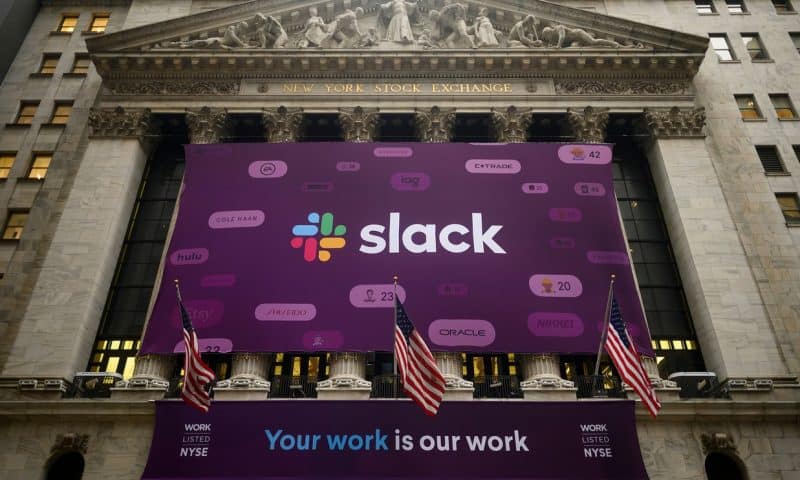Slack revenue tops $200 million for first time, but stock tanks after slight forecast change
Slack Technologies Inc. revenue topped $200 million in a quarter for the first time, but the stock still sank hard in the extended session Thursday afternoon after closing at record highs in recent days.
Slack reported a loss of $74.4 million, or 13 cents a share, on revenue of $201.7 million, up 50% from $134.8 million a year ago. After adjusting for stock-based compensation and other factors, Slack reported a loss of 2 cents a share, compared with a loss of 23 cents a share a year ago. Analysts surveyed by FactSet had expected adjusted losses of 6 cents a share on sales of $186.2 million.
Like Zoom Video Communications Inc. ZM, -6.03% , which reported record quarterly revenue and traffic late Tuesday, Slack WORK, -4.91% is reaping the digital rewards of a national work-from-home shift during the COVID-19 pandemic. In late April, Chief Executive Stewart Butterfield told MarketWatch that “simultaneously connected” users on his software grew by 25% in a single week in March, and that the company added 9,000 new paid customers from Feb. 1 to March 25, an 80% increase over the full quarterly total the preceding two quarters.
“There is a generational change in the way people work,” Butterfield told MarketWatch in a phone interview late Thursday. The work-from-home movement, he added, “will continue to catalyze adoption for the new category of channel-based messaging platforms we created and for which we are still the only enterprise-grade offering.”
He was more empathic later in a conference call with analysts, calling the quarter “phenomenal.”
“Tens of thousands of organizations, and millions of users” joined Slack, and used it increasingly, as more Americans worked from home in what could become a permanent shift for many, Butterfield added.
Slack did not pump up its annual forecast like Zoom, which may have weighed on the stock. Slack said it now expects annual revenue of $855 million to $870 million, after previously stating $842 million to $862 million. When Zoom updated its annual forecast earlier this week, it nearly doubled the sales projection and almost tripled its profit outlook. Slack said it now expects adjusted losses of 17 cents to 19 cents a share, after previously stating 19 cents to 21 cents a share.
Shares plunged 17% in after-hours trading Thursday after rising 68% this year and closing at an all-time high on Wednesday. The stock dipped 4.9% from that record high in Thursday’s regular trading session.
Slack now has 122,000 paying customers, but still pales in comparison to rival Microsoft Corp. MSFT, -1.31% and its competing Teams product, with 75 million daily active users and 200 million daily meeting participants. Microsoft added 31 million daily users in just over a month.
Slack points out that comparing paying customers and daily active users doesn’t give a full picture. Some of its paid customers such as International Business Machines Corp. IBM, -0.12% , it says, have hundreds of thousands of users. Indeed, during the quarter, Slack added Verizon Communications Inc. VZ, +0.68% and Amazon.com Inc. AMZN, -0.71% as customers. The partnership with Amazon is particularly crucial. Under the multi-year enterprise-wide deal, all Amazon employees will start to use Slack. Additionally, Slack announced a strategic alliance with Amazon Web Services.
The addition of Amazon and Verizon — two of the biggest deals landed by Slack — won’t just add tens of thousands of users in short order but potentially many more as Slack’s app gains traction within those companies over the years, Butterfield told MarketWatch.
Slack must continue to fight an uphill struggle because Microsoft, with mega-customers like Coca-Cola Co. KO, +0.04% and General Electric Co. GE, +5.16% , has the built-in advantage of leveraging an installed base at large enterprises with its Office 365 suite of productivity software.
In an interview with MarketWatch in April, Butterfield underscored the fierce loyalty of Slack customers in the face of the Microsoft threat.
“You probably sense the frustration in my voice,” he said. “Microsoft has made a huge push the past three years with a free service, but can you find a single Slack enterprise customer who has switched to Teams?”
Slack’s stock is up 68% this year. The broader S&P 500 index SPX, -0.33% is down 3.7% in 2020.

